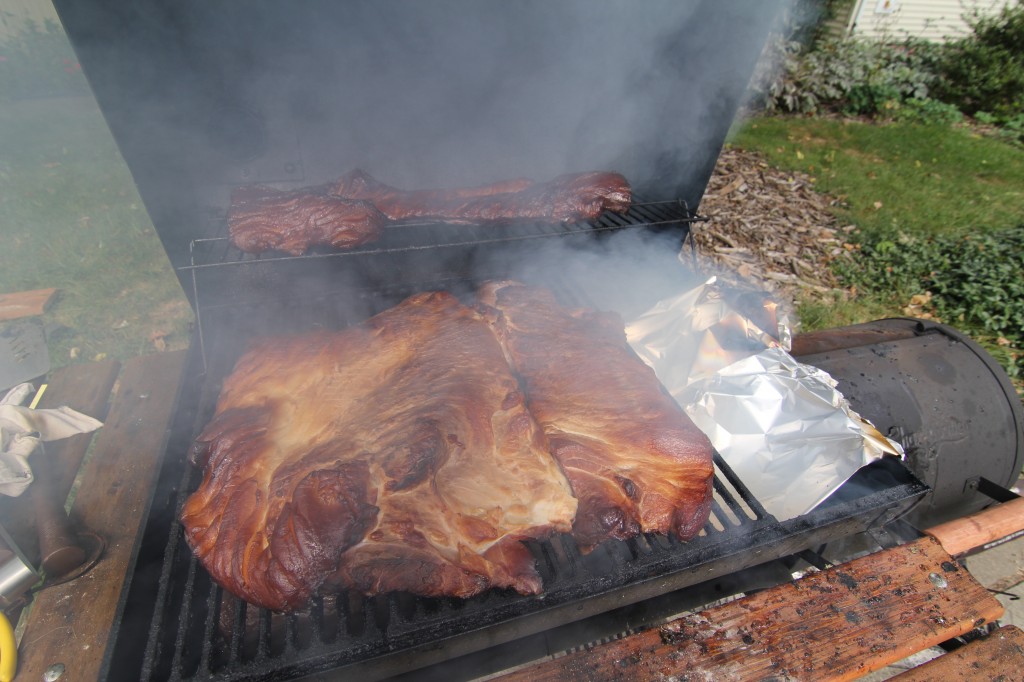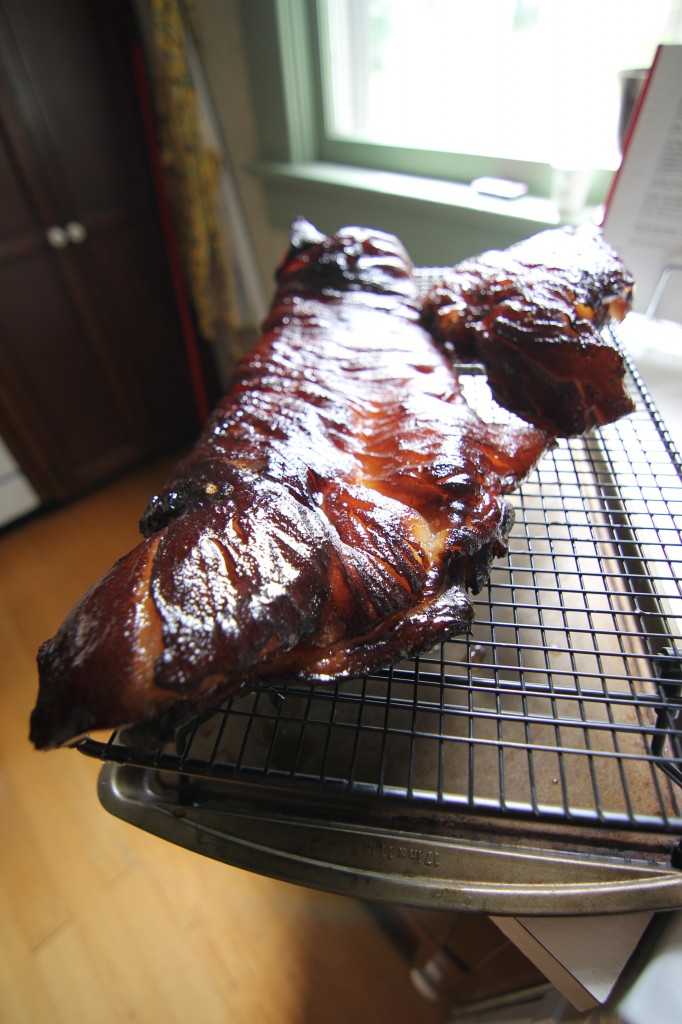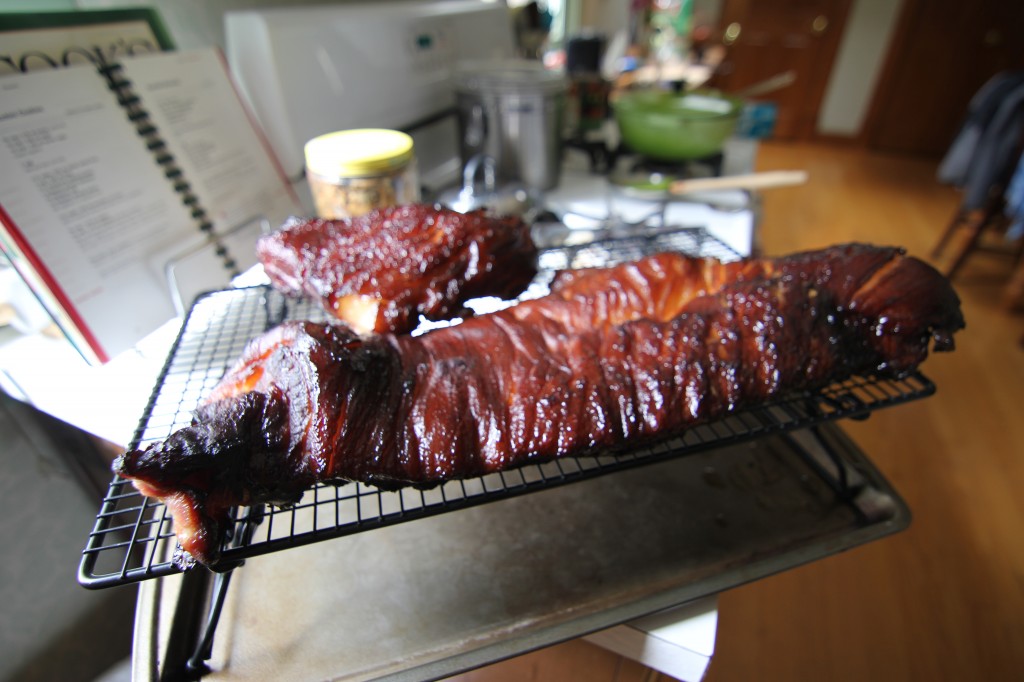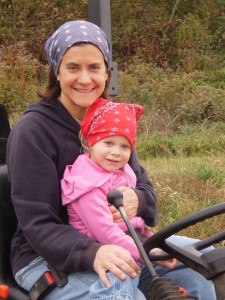Loading Pigs REALLY FAST
Next in our series of sped-up videos shot from the top of farm vehicles, here’s us loading the first two or three pigs onto our trailer for the trip to the butcher this Monday. Then the battery in my camera died.
[vimeo http://vimeo.com/29091731 w=640&h=360]
This may seem like a pretty low-tech affair, but the corral and chute system we’re using now is highly evolved and the result of many dusty and exhausting hours spent not being successful getting pigs onto trailers. At first we built square corrals with a chute on one side. Then we realized the chute works better in a corner. Then we learned that the ramps into the trailer should have sides because pigs don’t like heights. Then we started making curved corrals so there aren’t any corners to get pigs stuck in.
By the time we did the last batch of last year, we loaded 11 gigantic porkers onto our trailer in under ten minutes and felt pretty clever indeed. The load you see here is a bit trickier because we’re working hard to get the largest (also most dominant and ornery) pigs out of the herd and onto the trailer first so we can get the others properly fattened as well – not that any of these pigs is lacking in size.
We’ve also figured out a few distinct loading jobs. This time Elise was luring pigs to the ramp with feed, then gating the trailer door so the pigs on the trailer can’t get back off even when more are getting on. I was corralling pigs to the chute (the easy job.) Tom did the majority of ooshing pigs up the ramp and admitted to being a bit sore the next morning.
The next refinement we’ve talked about is splitting the corral in half so we can sort the pigs better in a situation like this and making better use of the gate at the top of the chute – it’s a bit hard to see, but there’s a part of a hog panel jutting up at the corner of the trailer in the video which can be opened to let an unwanted hog off the ramp so it doesn’t get into the trailer. Obviously that wasn’t a problem this time.
Moving Pigs REALLY FAST
Part of keeping pigs outside is rotating them to fresh pasture when they root up their current location. We’ve figured it that can be pretty easy if we let them get just a little hungry and then move the feed and water – they follow us right over, and we close the fence behind them. Here’s what that looks like…
[vimeo http://vimeo.com/28732471 w=640&h=360]
The shot is of the new area – they had been to the left (you can’t quite see the single strand of electric fence over there.) First we drag the waterer over, then the smaller feeders, then we roll in the big feeder and put out some feed. All the pigs come over at the same time and we close the fence behind them, which is what we’re doing over to the side when the video ends.
The reason for the different types of feeders is that a large, dominant, greedy pig can prevent other pigs from eating if all the feed is in one place. Those green (I know, everything looks green in this video) satellite feeders help spread out the eating opportunities so all the pigs grow at a more even rate.
Also, as an addition to Tom’s butchering post, here’s the upside of having to butcher a pig – HOMEMADE BACON!
Pig Butchering
Well life isn’t always glorious on the farm, and animals sometimes get sick. We sadly had a pig develop seizures due to infection in the brain. It is not clear why this would happen, but the vet assured us the pig would be perfectly edible. So we decided to butcher it ourselves and make bacon, sausage, prosciutto, pork chops, and other delicious treats to eat ourselves.
When it became clear we would need to butcher this pig I felt heavy. We have plenty of other work to do these days, and butchering takes a full day plus. But we prepared the necessary equipment and 3 of us finished the killing, gutting, skinning, and quartering in reasonable time.
I (Tom) have butchered 5 or 6 hogs now, and this one went by far the smoothest of any. I suppose experience pays off. I actually thoroughly enjoy the process, minus the killing part. My experiences butchering have given me greater understanding as to why certain muscles and cuts of meat work better for roasts, or sausage, or bacon in the case of the pig’s belly.
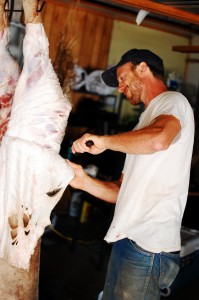 My butchering experiences have also taught me the joy and value of community work. We have often turned various days that would otherwise simply be heavy with the work of slaughter into days of celebrating life and work together with friends and family. Many tasks must be accomplished and people with different levels of comfort with the process can participate, from packaging cuts of meat, to making music, to providing delicious meals. So thank you to everyone who has helped me butcher in the past, and who might in the future.
My butchering experiences have also taught me the joy and value of community work. We have often turned various days that would otherwise simply be heavy with the work of slaughter into days of celebrating life and work together with friends and family. Many tasks must be accomplished and people with different levels of comfort with the process can participate, from packaging cuts of meat, to making music, to providing delicious meals. So thank you to everyone who has helped me butcher in the past, and who might in the future.
Baby Turkeys at Red Tail!
Here’s a video of some current farm residents – four week old Turkeys:
[vimeo http://vimeo.com/28150253 w=640&h=360]
They’re in the high-tech brooder at Red Tail Farm in Goshen, waiting to go out to pasture in about a week. They start slow, but they’ll be ready by Thanksgiving – we even have a few left, so sign up if you haven’t yet.
Hello from Blue Heron!
We love to eat, and to eat well.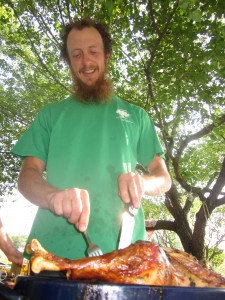 That simple fact contributed greatly to the fact that we farm. For us to eat well begins with fruits, vegetables, grains, and animals that are raised well. Our farming continues to teach us what it means to do just that. Care of course must be taken in all parts of the process of eating, and so we also consider harvesting/butchering, cooking in the kitchen, and presentation of food important. We hope this blog/website will give you a glimpse of some of those processes as we experience them from field to table.
That simple fact contributed greatly to the fact that we farm. For us to eat well begins with fruits, vegetables, grains, and animals that are raised well. Our farming continues to teach us what it means to do just that. Care of course must be taken in all parts of the process of eating, and so we also consider harvesting/butchering, cooking in the kitchen, and presentation of food important. We hope this blog/website will give you a glimpse of some of those processes as we experience them from field to table.
So who are we really? Blue Heron Farm of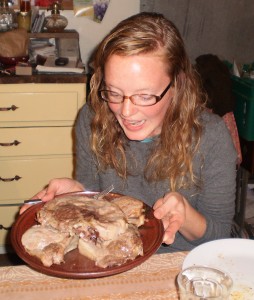 course. A group of folks-Tom, Casandra, and Susana, and Elise and Adam. Hopefully you’ll get to know us each a little better as time goes by. We farm in several locations, with our primary activity taking place along the Elkhart River southeast of Goshen, IN. That is the farm so named “Blue Heron” and the home of Tom, Casandra, and Susana. Elise and Adam reside in Goshen and utilize pastures there. Together we work on the major animal husbandry tasks and the marketing/sales of the meat we produce.
course. A group of folks-Tom, Casandra, and Susana, and Elise and Adam. Hopefully you’ll get to know us each a little better as time goes by. We farm in several locations, with our primary activity taking place along the Elkhart River southeast of Goshen, IN. That is the farm so named “Blue Heron” and the home of Tom, Casandra, and Susana. Elise and Adam reside in Goshen and utilize pastures there. Together we work on the major animal husbandry tasks and the marketing/sales of the meat we produce.
Please check out the individual pages full of valuable and interesting info on the animals we raise, how to reach us, and how to purchase meat from us. We think you’ll like it.
